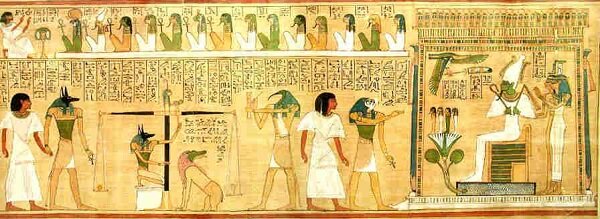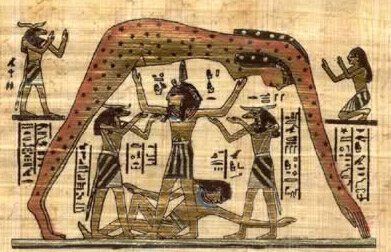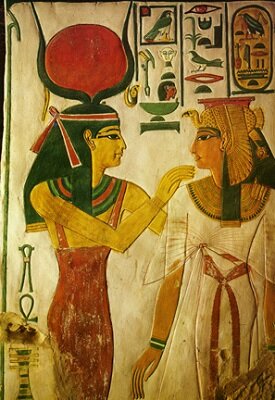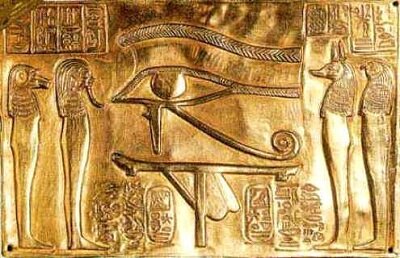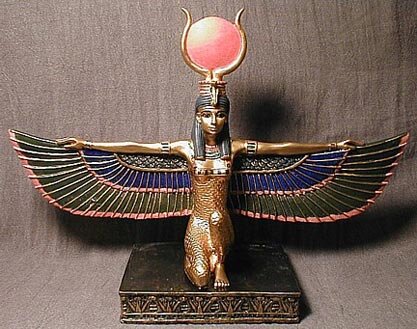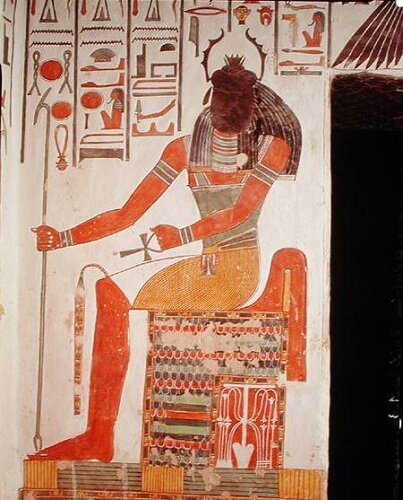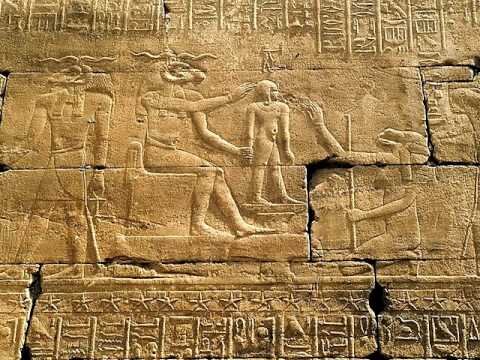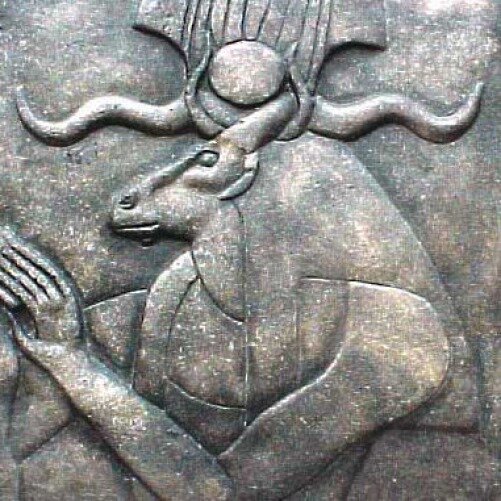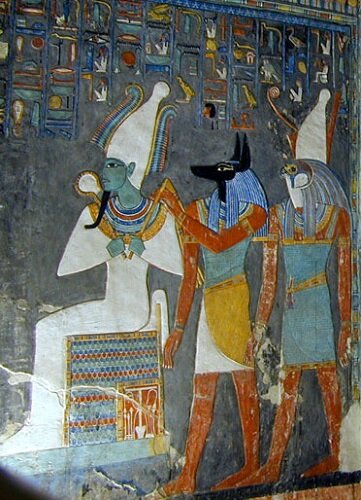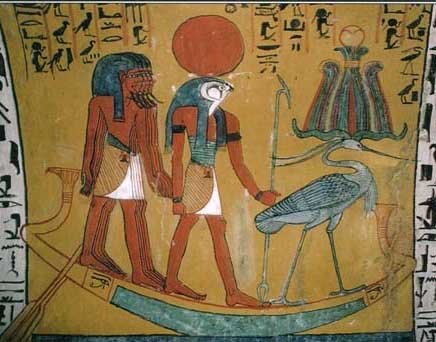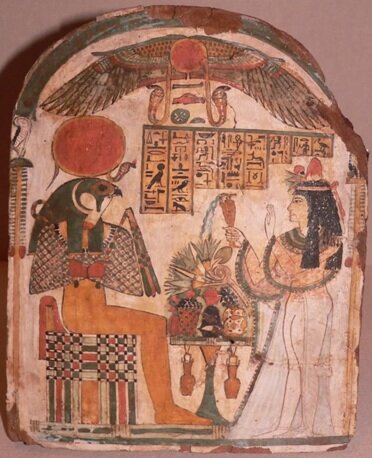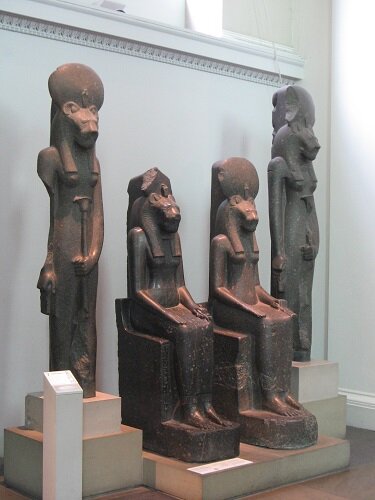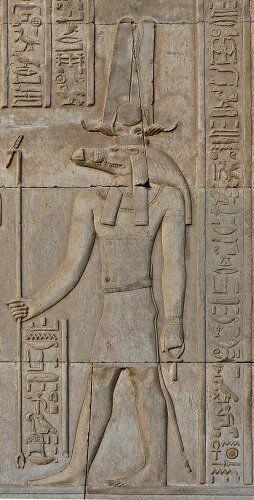The Sunday Section: Ancient Egypt - Gods and Goddesses
In Ancient Egypt, deities were an integral part of society. It was believed that they were immanent in natural forces, and were present in the world, influencing, not only the lives of the people, but also natural events. Egyptians prayed for divine assistance in their daily lives, turned to the gods for advice, and used rituals to compel the deities to act.
Papyrus of Hunefer
The link between the people and gods was the pharaoh, for he was believed to be divine. As such, pharaohs were usually depicted in the company of the deities, with many of them referred to as the ‘son’ of deities, especially Osiris and Ra. Temple-building was seen as exclusively the work of the pharaoh, as were the rituals that the priests performed on his behalf. These helped the pharaoh maintain ma’at or order, which provided the gods with the order that was essential for them to perform their functions, which ensured the people’s continued existence.
Set (L) and Horus (R) adoring Ramesses in the small temple at Abu Simbel
The gods – ntr, and goddesses – ntrt, especially the major ones, had more than one role, and were involved in different phenomena. For example, Khnum, being the god of Elephantine Island, located on the Nile, was responsible for the annual inundation of the Nile. He was also said to create all living things, shaping them on a potter’s wheel. Another example is the sun god – Ra was not the only one; this role was also shared by Atum, Khepri, and Horus.
Although they had diverse functions, most of the gods and goddesses had one role in common – maintaining ma’at or divine order, which was a central principle of the religion; the concept of ma’at itself was personified as a goddess. However, there were those who represented disruption to ma’at, namely Apep, who represented the forces of chaos.
Despite their divine status, in myth, the gods were depicted more like humans. They felt emotion; they ate and drank; they fought, sickened and died. Their behaviour was inconsistent, with little or no insight into their thoughts and motivations. The myths seemed to care little for well-developed plots, as the symbolic meaning was seen as more important than elaborate storytelling.
The following list of deities is, by no means, complete; neither are the descriptions. To make things easier, I’ve listed them alphabetically.
Amun, one of the most important and powerful gods in Ancient Egypt, was called the ‘King of the gods’. During the New Kingdom, which was between the 16th and 11th century BC, Amun was combined with the sun god, Ra, and was called Amun-Ra. It was believed that he was the father and protector of subsequent pharaohs. During this time, women’s role in society grew; they held positions of authority and responsibility, and wielded great powers.
Amun
Anubis, represented as a man with the head of a jackal, is the protector of the dead, ushering them into the underworld. He is also the god of embalming; it was he who was responsible for embalming the dead body of Osiris after the latter had been killed by Set. As the god of mummification, Anubis watched over the process of mummifying the dead; this is the reason why priests wore a mask of Anubis during the mummification process. In preserving the body of the dead, sweet smelling herbs and plants were used, the belief being that it would help the deceased on his way to the afterlife. It was thought that Anubis would sniff the mummy, and only those who smelled pure would be led to Duat, the realm of the dead.
Anubis
Apep, or Apophis, the serpent god, represented chaos, darkness and destruction. He is the absolute enemy of Ra, threatening the sun god during his nightly travels across the sky. If Apep were to ever successfully devour Ra, the world would be plunged into darkness, and creation itself would be destroyed.
Apep being speared by Set
Aten is a form of the sun god, Ra, and was made the ‘king’ of the gods during the reign of Akhenaten.
Aten, the sun-disc, being worshipped by Akhenaten
Atum is the God of Creator. He was believed to have risen from the waters of chaos, after which he created all the gods.
Atum on Nefertari’s tomb
Bastet, one of the most well-loved goddesses of Egypt, and a daughter of Ra, is the goddess of cats, the home, fire, music, dance, and pleasure, as well as sexuality, fertility, pregnant women and children. Because of her, cats were held in high regard by Egyptians; any crimes against cats were considered unlucky. Cats were also considered holy, and after they died, temple cats were mummified and presented to the goddess as offerings. There were two sides to Bastet, the gentle goddess who was a protector of homes and pregnant women, and the aggressive goddess who battled ferociously to protect the pharaoh; in this persona, she takes the form of her twin sister, Sekhmet.
Bastet
‘The Obsequies of an Egyptian Cat’ ~ John Reinhard Weguelin
Bes is the protector of pregnant women, newborn babies, and the family. It is thought that he must have been African in origin because his appearance is very different. He is depicted as a dwarf, heavily bearded, with bow legs, and, although savage in appearance, is seen as comical. He also brings good luck and happiness to homes.
Bes, at Dendera (Steve FE Cameron)
Geb, the god of the earth, was the son of Shu, the god of air, and Tefnut, the goddess of moisture. He was, both, brother and husband to the sky goddess, Nut. Their children were Osiris, Set, Isis and Nephthys.
Geb is shown reclining on the ground, with Nut above him; their father, Shu, is holding her up
Nut is a sky goddess, whose body, covered in stars, forms a canopy over the earth, her brother-husband, Geb. It is believed that at night, Nut and Geb meet as the goddess comes down from the sky, causing darkness. During storms, she comes ever closer to Geb, causing weather disturbances. To stop them forming a tight, eternal embrace, Ra ordered their father, Shu, to separate them. If he fails in his duty, the embrace of earth and sky would disrupt divine order and cause chaos.
Shu is the god of the air. It’s his duty, given to him by Ra, to hold up the figure of Nut, to ensure that his children, the earth and sky, are forever kept separate.
Hapy, the god of the Nile, was especially important because he brought the yearly flood, which deposited rich silt on the banks of the Nile.
Hapy
Hathor, the daughter of Ra and the sky goddess, Nut, was one of the most popular goddesses in Egypt. She is often depicted as a woman with the head of a cow, or a woman with 2 curled cow’s horns between which are suspended a solar disc and the uraeus, the rearing cobra. The wife of Horus, she is the goddess of beauty, music and dance, of love, and of women, especially pregnant ones. She was so popular that it was believed the other goddesses were forms of her. She was seen as a sun goddess, and a moon goddess, a goddess of the east and west, a goddess of fertility, of agriculture, even of the underworld.
Hathor, on Nefertari’s tomb
Horus, the son of Osiris and Isis, is probably best-known as the protector of the ruler of Egypt. After Osiris was murdered by his brother, Set, Horus fought Set for the throne of Egypt. During the battle, Horus lost one of his eyes, which was later restored to him. This – the Eye of Horus – became a symbol of protection for the Ancient Egyptians. After the battle, Horus was chosen to be the ruler of the world of the living. Because of the pharaoh’s connection to Horus, pharaohs were seen as the ‘living Horus’.
Horus, Temple of Philae
The Eye of Horus, flanked by the Four Sons of Horus
Isis, the first daughter of Geb and Nut, is the goddess of magic, fertility and motherhood, death, healing and rebirth. The most revered goddess in Egypt, she is the sister and wife of Osiris, and mother of Horus. A combination of a terrestrial, water and air goddess, she is seen as the complete female from which all life sprung.
Isis
Khepri is the god of creation, of life and resurrection. He also represents the movement of the sun. His name literally means ‘He Who is Coming into Being’. He is depicted as a man with the head of a scarab, or as the scarab beetle itself.
Khepri, scarab symbol
Khepri
Khnum is a creator god, fashioning people on a potter’s wheel, and is also connected with the inundation of the Nile.
Khnum fashioning man on potter’s wheel
Khnum fashioning man on potter's wheel
Khnum
Ma’at, a daughter of Ra, came into being when the god rose from the waters of Nun. She is said to have brought order to the chaos by balancing the behaviour of the stars, the seasons, the mortals, and even the deities. As such, she is the goddess of divine order, truth, justice and harmony – the balance of things on earth. She is the wife of Thoth. The vizier in charge of the law courts was known as the ‘priest of Ma’at’. In a civil trial, the term, Ma’at Kheru, would be identified with the party that is declared innocent and true – ‘true of voice’ or ‘justified’. Ma’at’s symbol was the ostrich feather. In the deceased’s final trial, his heart would be weighed against Ma’at in the form of an ostrich feather. The heart was believed to be ‘the seat of intelligence and moral judgment, as well of emotions’. If the deceased had led a good and decent life, his heart would be in balance, and he would pass into the Afterlife. But if his heart did not balance with Ma’at, it would consumed by the Devourer.
Ma’at
Nephthys is a protective goddess of the dead. The sister of Isis, Osiris and Set, she is also the wife of Set, and the mother of Anubis.
Nephthys
Nun is one of the oldest Egyptian gods. His name means ‘primeval waters’, and it is from these waters that creation began as land that rose out of Nun. Nun has no gender, but can be either male or female; Nun is the male aspect, and Naunet, the female.
Nun holding and guiding the boat along the water
Osiris, best-known as the god of the dead, and ruler of the underworld, is also a god of resurrection and fertility. He is the brother/husband of Isis, and the brother of Nephthys and Set, and father of Horus.
(Lto R) Osiris, Anubis, Horus
Ptah is the god of craftsmen. According to myth, the universe came into existence through his words and thoughts – he spoke the words and the world came into being. As a craftsman, he is said to have carved the bodies in which the souls of men would dwell in the afterlife.
Ptah
Ra, the sun god, is the most important god of the Ancient Egyptians. They believed that he was swallowed every night by the sky goddess, Nut, and was reborn every morning. However, they also believed that he travelled through the underworld at night, where he fought Apep, whom he vanquished every night.
Ra in his solar boat (c. 1200BC)
Ra-Horakhty, the 'Great God, Lord of the Sky', was a combination of the gods, Ra and Horus. As Ra was a god of the sun, and Horus, a god of the sky, Ra-Horakthy was thought of as the god of the rising sun.
Ra-Horakhty, the ‘Great God, Lord of the Sky’
Sekhmet, the ferocious twin of Bastet, is a goddess of war, the sun, destruction, plagues, and healing. She is one of the oldest deities, and one of the most powerful. As a sun goddess, she is known by the name, Nesert, which means flame. She is also known as ‘The Scarlet Lady’, because of her lust for blood. After a war, celebrations and sacrifices are usually offered to appease her.
Sekhmet - British Museum (own photo)
Seshat is the goddess and patron of architecture, astrology, astronomy, building and surveying, measurement and mathematics. She is believed to be the inventor of writing, and her name means ‘she who scrivens’, or ‘she who scribes’. However, it was her spouse, Thoth – though sometimes she is seen as his female aspect – who brought writing to the people.
Seshat
Set is the god of chaos, storms, desert and darkness. At one time, he was worshipped as the god of wind and the desert storms, and was an ally of Osiris, and the defender of their father, Ra. But, for some reason, this view changed, and he came to represent all that threatened harmony.
Set
Sobek, the Crocodile god, protects the people, and ensures their fertility and that of their crops.
Sobek
Tawaret is the goddess of fertility, maternity and childbirth, and is the patron of women and children. She is traditionally believed to be the wife of Apep, the demon god. During childbirth, she wards off evil spirits who intend to harm the baby and mother.
Tawaret - British Museum (own photo)
Tawaret
Tefnut is the goddess of moisture, and is the wife of Shu, and the mother of Nut and Geb.
Tefnut
Thoth is the god of writing and knowledge. Connected with the moon, and magic, he is also involved in arbitration, and the judging of the dead.
Thoth
